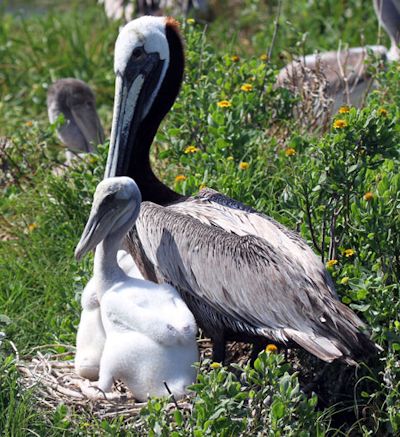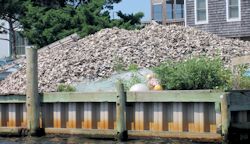 Gene Ballance and James Barrie Gaskill have been building oyster reefs to slow erosion at Beacon Island in Pamlico Sound. It’s one of the few brown pelican rookeries in the state. Photo: Todd Miller |
OCRACOKE — In an age when people routinely use leaf blowers and riding mowers to groom their tiny yards, James Barrie Gaskill and Gene Ballance seem to think nothing of the arduous physical work of shoveling tons of oyster shells into two-bushel totes and loading them onto a barge to later dump overboard.
The two life-long watermen, both north of 60 years, have the satisfaction of knowing the hours of labor could restore historic oyster beds in the sound off their native Ocracoke Island.
Supporter Spotlight
The N.C. Coastal Federation recently recognized Gaskill and Ballance with a 2013 Pelican Award for their commitment to restoring the coastal habitat.
Funded by a grant to the federation and Audubon North Carolina, the men are in the process of rebuilding oyster reefs off Beacon Island in Pamlico Sound. The 7.5-acre island is one of the last brown pelican rookeries in the state. The oyster beds around the island had been established generations ago before being decimated by disease and other factors.
Last year, the men started building a “living shoreline” off Springer’s Point Preserve on Ocracoke with rows of 2-foot by 8-foot mesh bags of oyster shells. That part of the project was completed in June.
“If it stays there long enough, the oysters will kind of cement it together,” said Ballance, showing off the work from his 18-foot Southern Skimmer that bobbed in the water just off the shoreline. “A bulkhead won’t grow, but this will grow. It will heal itself.”
In just the short period the 100 yards of living reef have been in place on the eroding southwest side of Springer’s Point, oysters have started growing and the land has filled in around the threatened centuries-old oak trees, he said.
Supporter Spotlight
“This looks a lot better down here than it did,” Ballance said, beckoning toward a cliff with a stand of oak trees. Nearby, a young family played on a sandy beach, which Ballance said was created by the natural wave action that would be diminished if the reef was too long.
 James Barrie Gaskill, left, and Gene Ballance receive their Pelican Award from the N.C. Coastal Federation’s Erin Fleckenstein, left, and Lexia Weaver. |
“It’s one of those things –you kind of balance the good things,” he said. “You don’t want to make it so people don’t want to use it.”
Ballance, 61, a former Hyde County commissioner, also works at old Ocracoke Seafood, keeping fish house records and assisting fishermen in compiling trip data that must be submitted to the state.
On the other side of the island in Ocracoke Inlet, near where Civil War-era Fort Ocracoke had been, Ballance and Gaskill have been transporting the tubs of shells across Pamlico Sound to Beacon Island. Right off the west side of the island, shadowy rows of shells between rows of white stakes can be seen under the shallow water. The location matches the old Winslow maps of the late 19th-century public oyster beds that were remapped in 2005 by Ballance in a North Carolina Sea Grant-funded project.
When the Beacon Island project is completed by Oct. 31, the goal is that there will be nine 100-foot by 20-foot reefs, arranged in three rows of three. Some of the stakes, in place to lean against when dumping the totes, will be removed, but the others will stay as markers.
Not only do oysters filter and clean the water, their reefs are good habitat for fish. If things go well, in about three years, there will be full-size oysters on the reef, and it will continue to build on itself.
Gaskill, 70, a member of the federation board of directors for about 20 years, has been working mostly as a volunteer, but Ballance has been doing the job as a contractor.
 Gene Ballance loads oyster shells on his boat for a trip to Beacon Island. Photo: Catherine Kozak |
“We’ve been friends much of our lives, but we never did pal around much,” Gaskill said, attributing that to their age difference. “This is the first time we’ve worked together.”
The shells have been brought by truck from the Gulf Coast to Elizabeth City and then to Ocracoke Island, where they are dumped in huge hills containing 40,000 pounds of shells next to Gaskill’s dock alongside Oyster Creek. The barge holds 100 totes, each weighing 80 pounds dry or 100 pounds wet, totaling 200 bushels of shells.
The project wouldn’t be possible in the shallow water without the barge, which draws six inches empty and 16 inches fully loaded. The vessel was purchased originally by the Ocracoke Working Watermen’s Association, through a grant to the Ocracoke Foundation, and later sold to Cape Dredging Co., which now leases it back to the watermen as needed.
Grabbing a shovel, Ballance demonstrated the well-honed technique involved in filling the oyster shell totes – a combination of shoveling like a muckraker and using gravity to scoop them down into the tub from the side of the hill.
“There’s a method to this madness,” he said. “If you watch what you’re doing, you get real good at this after a while.”
A clam rake rigged to a ladder assists in pulling the plastic tote on the ladder to the barge.
“That’s how they built the pyramids –ramps like that,” Ballance joked.
Half of the shells are loaded in the morning about two hours after sunrise, and the other half about two hours before sunset.
Nearly all of the work has been done by the two watermen, with the assistance of Gaskill’s 61-year-old wife on the weekends. Despite what people have assumed, Ballance said that the work cannot be done by a backhoe or other equipment because of its small scale and the shallow water. For whatever reason, he added, younger folks have not been around much to help.
 That’s a pile of shells behind James Barrie Gaskill’s house on Ocracoke. Photo: Catherine Kozak |
“You can’t get them to do work all day,” Ballance said matter-of-factly. “They would jog all day long rather than do that.”
Gaskill has been working on the project around his regular fishing jobs. In the summer, he sells fresh shrimp, clams and crab seven days a week off of his truck. In the fall he fishes for flounder, and in the spring, for trout, bluefish and Spanish mackerel. In between, he also raises clams, as well as clamming in the sound.
For a time after he graduated from East Carolina University in the late 1960s, Gaskill had a job teaching at Ocracoke School –when Ballance was still in high school. That lasted about four years before he went back to commercial fishing.
“Not everybody is cut out to be a teacher,” he said. “I didn’t like it.”
Gaskill’s wife, Ellen, however, did take to the profession, and is a computer teacher in Beaufort, where she lives part-time. But she is also not averse to lending a hand with the oyster project.
“She gets out here and shovels,” he said.
In his modest fashion, Ballance, 61, said he wasn’t quite sure what the Pelican award was at first, nor did he appear too impressed with himself.
“Yeah, I hang it on the wall –I have other ones I haven’t put on the wall,” he said dryly. “I think it’s to show what we’re doing and how we can help. A lot of people helped – a lot of pieces fell together.”
Gaskill said he enjoys the work he has done for the federation, including picking up groups of staff or members in his boat. But he wasn’t even thinking about scoring a Pelican Award for his volunteer effort on the oyster reef project.
“I didn’t expect to get nothing like this,” he said in his thick Ocracoke brogue. “Gene and I volunteer a lot.”







